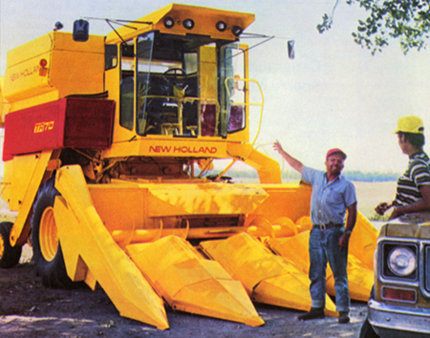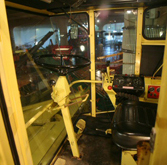| |
The modern, self-propelled combine is versatile. By changing the front cutter section, or head, a combine can harvest a variety of different crops, from small grains such as wheat, rye and oats, to rice, corn and soybeans. The Sperry-New Holland machine in Henry Ford Museum has a corn harvesting head (front end attachment). In a single pass, it can cut down cornstalks, separate and husk the ears, chop the stalks for fodder, and shell the kernels from the ears.
Commercially successful combines are relatively new, but the idea of a combine is something that farmers have been trying to perfect for many years. The first successful combine was demonstrated by Hiram Moore and John Hascall in Climax, Michigan, in 1834. Large horse-drawn and tractor-drawn combines were developed in the early 1900s--but could only be used on very large farms with big fields because they were very large and unwieldy. The first commercially successful, self-propelled combine that could operate in a variety of conditions was the 1938 Massey-Harris No. 20, also on exhibit in Henry Ford Museum. It was the first modern combine.
Sperry-New Holland TR70 Combine
This Sperry-New Holland TR70 Axial Flow Combine was a major step forward in the speed and efficiency of combines. Earlier combines, such as the Massey-Harris, threshed the grain by bouncing it along the conveyor belts on the cutting head. These “strawwalker” combines used the force of gravity to remove and separate the kernel from the stalk. Their processing capacity was limited by the speed of the strawwalker, and by the width of public roads on which it traveled from field to field. The Sperry-New Holland TR70 replaced the strawwalkers with twin axial flow rotors, patented by Sperry-New Holland in 1975. The rotors had two major advantages over the strawwalkers:
- The rotors replaced gravitational force with centrifugal (spinning) force, and ran the grain over multiple threshing plates, which did a more complete job.
- The rotors were positioned along the length of the combine, so the capacity of the combine could be increased without making it wider.
The Sperry-New Holland TR70 was initially most effective with crops with heavier kernels, such as corn and soybeans, but as this design was perfected, it soon replaced strawwalker-based combines for all grains.
The serial number of the museum’s combine is 1975-1, indicating it was the first one built. It is likely a hand-built, pre-production unit, used to promote the new model at demonstrations and agricultural shows. The many promotional decals on the sides of the combine would suggest this as well. It probably was never used in an actual harvest.
 |
| Shown in this 1975 advertising image, the Sperry-New Holland TR-70 combine promised to open great new opportunities for increased productivity at harvest time. ID.THF69333 - Photograph courtesy of American Society of Agricultural and Biological Engineers |
The Combine’s Effect on Farming
In the 1830s, it took 250-300 man hours to plant and harvest 100 bushels of wheat. By 1975, when the museum’s Sperry-New Holland combine was built, it took three hours to produce the same 100 bushels of wheat. Much of this time savings came from the invention of machines to do the hard work of harvesting, rather than people.
The combine replaced many traditional agricultural tools and implements: the sickle, scythe, grain cradle, reaper, binder, flail, thresher, winnowing basket, fanning mill, separator, corn knife, husking palm, corn picker, corn husker corn sheller--and of course, horses, mules and oxen.
With less labor needed to produce the nation’s food, people left the farm for the newly developing industrial cities as the United States was transformed from a rural to an urban nation. Many of us have parents or grandparents that lived on a farm, but now farmers represent only a tiny fraction of the workforce.
| |
-- Jim McCabe, Curator of Agriculture |
A “Farmer’s Eye View” from the Sperry-New Holland Combine
Visitors to Henry Ford Museum can now enjoy a “farmer’s eye view” from the cab of our 1975 Sperry-New Holland combine.

|
Looking out from the cab of the Sperry-New Holland combine in Henry Ford Museum. ID.THF57476
|
|
|
|

